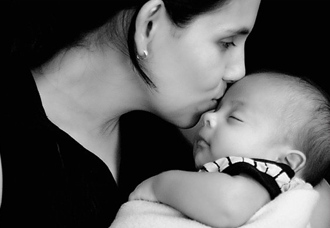Millions of people are spending time to shop for presents for Mother's Day, which is Sunday.
Most shoppers overlook that most mothers would rather have the presence of their children instead of the presents. Many of us don't live close to our parents, so it may take a phone call to provide that presence.
 A mother and child Photo: Edwin DalorzoBy the way, if mom lives in Britian, Ireland of Nigeria, you've already missed your chance. Mothers are honored in those countries during Lent. But you have until June if your mother lives in Mongolia, Luxembourg or Kenya.
A mother and child Photo: Edwin DalorzoBy the way, if mom lives in Britian, Ireland of Nigeria, you've already missed your chance. Mothers are honored in those countries during Lent. But you have until June if your mother lives in Mongolia, Luxembourg or Kenya.
The message here is that mothers are honored and respected around the world.
Marriage, raising children and parenting are huge challenges. Throw a job into the mix to add to the load.
Check the numbers about motherhood and the job seems even more daunting.
How Many Mothers
85.4 millionEstimated number of mothers in millions in the United States in 2008. Source: Survey of Income and Program Participation, 2008 Panel Wave 2, unpublished tabulations.
54%Percentage of 15- to 44-year-old women who were mothers in 2008. Source:Fertility of American Women: 2008
82%Percentage of women 40 to 44 who had given birth as of 2008. In 1976, 90 percent of women in that age group had given birth. Source: Fertility of American Women: 2008
How Many Children
94%Among the 37.8 million mothers living with children younger than 18 in 2004, the percentage who lived with their biological children only. In addition, 3 percent lived with stepchildren, 2 percent with any adopted children and less than 1 percent with any foster children. PDF Source: Living Arrangements of Children: 2004
Moms who've recently given birth
4.13 million Number of births registered in the United States in 2009. Of this number, 409,840 were to teens 15 to 19 and 7,934 to mothers 45 to 54. Source: National Center for Health Statistics
25.1Average age of women in 2008 when they gave birth for the first time, up from 25.0 years in 2006 and 2007. The increase in the mean age from 2007 to 2008 reflects, in part, the relatively large decline in births to women under age 25 compared with the small decline for women in the 25-39 age bracket. Source: National Center for Health Statistics
40%Percentage of births that were the mother's first in 2008. Another 32 percent were the second-born; 17 percent, third; and 7 percent, fourth. Source: National Center for Health Statistics
18,986Number of births in 2008 that were the mother's eighth or more. Source: National Center for Health Statistics
42,746Number of births in 2008 that did not occur in hospitals. Of these, 28,357 were in a residence (home) and 12,014 were in a freestanding birthing center. Source: National Center for Health Statistics
62,682Number of triplet and higher order multiple births in 2008, the lowest number reported in more than a decade. The 2008 triplet and higher order multiple total included 5,877 triplets, 345 quadruplets, and 46 quintuplets and higher order multiples. Source:National Center for Health Statistics
71Number of births in the past year per 1,000 women 15 to 50 with a graduate or professional degree. These women have a higher fertility rate than those with any other level of education. Source: Fertility of American Women: 2008
Single Moms
9.9 millionThe number of single mothers living with children younger than 18 in 2010, up from 3.4 million in 1970. Source: America's Families and Living Arrangements
5.6 millionNumber of custodial mothers in millions who were due child support in 2007.Source: Child support
38%Of the 4 million women 15 to 44 years old who had a birth in the last year, 1.5 million (38 percent) were to women who were not married, who were separated, or married but with an absent spouse. Of those 1.5 million mothers, 425,000 (28 percent) were living with a cohabitating partner. Source: Fertility of American Women: 2008
Employed moms and moms-to-be
61%The proportion of mothers with a recent birth who were in the labor force increased from 57 percent in 2006 to 61 percent in 2008. Among states with higher than average levels of new mothers who were unemployed, the highest proportions were in Alabama (10 percent) and Michigan (9 percent), along with several states in the southeast United States. Source: Fertility of American Women: 2008
777,817Number of child care centers across the country in 2008. These included 74,920 centers employing 884,235 workers and another 702,897 self-employed people or other businesses without paid employees. Many mothers turn to these centers to help juggle motherhood and careers. Source: Nonemployer Statistics and County Business Patterns: 2008
Stay-at-home moms
5 millionNumber of stay-at-home moms in 2010 ‚down from 5.1 million in 2009 and 5.3 million in 2008 (the estimates for 2010 and 2009 are not statistically different). In 2010, 23 percent of married-couple family groups with children under 15 had a stay-at-home mother, up from 21 percent in 2000. In 2007, before the recession, stay-at-home mothers were found in 24 percent of married-couple family groups with children under 15. Source: America's Families and Living Arrangements and Table SHP-1
Compared with other moms, stay-at-home moms in 2007 were more likely to be:
- Younger: 44 percent were under 35 compared with 38 percent of mothers in the labor force.
- Hispanic: 27 percent compared with 16 percent of mothers in the labor force.
- Foreign-born: 34 percent compared with 19 percent of mothers in the labor force.
- Living with a preschool-age child: 57 percent compared with 43 percent of mothers in the labor force.
- Without a high school diploma: 19 percent versus 8 percent of mothers in the labor force.
